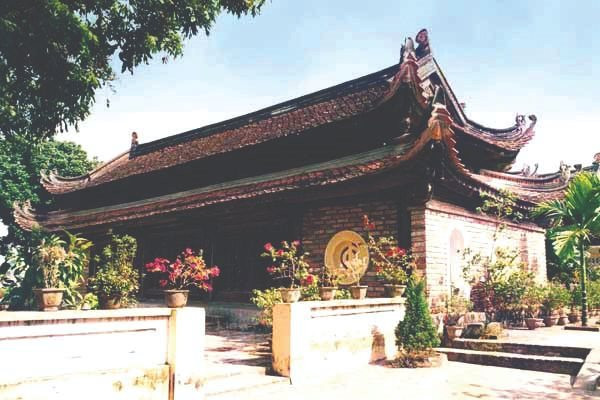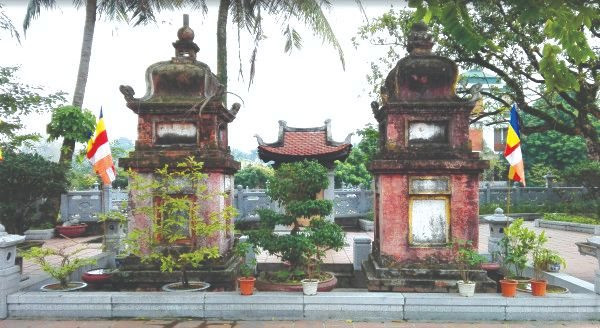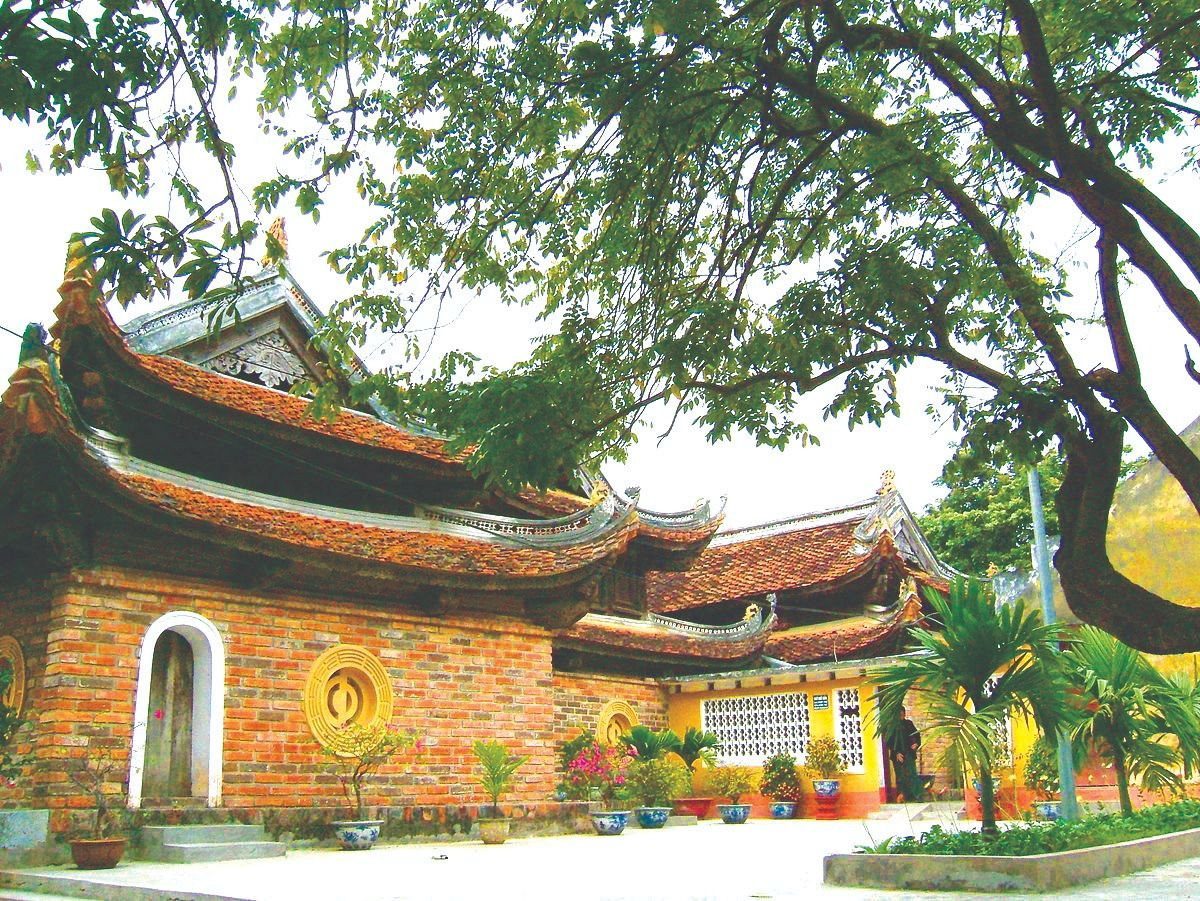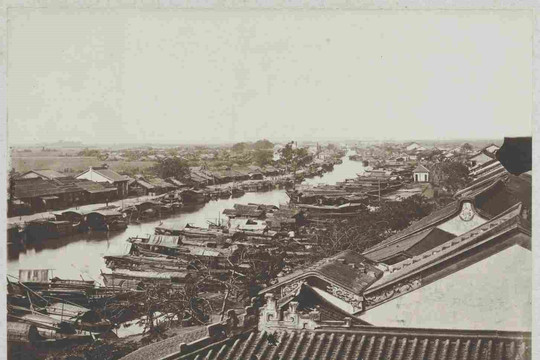However, during the reign of King Tran, the name was changed to “Tich Ma.” In the reign of King Le, it was changed again to “Nghi Tam.” The word “Tam” resembled the story of growing mulberries and raising silkworms from the time of Princess Tu Hoa, so it was later changed to “Nghi Tam.”
Formerly, Nghi Tam village was part of Thuong district, Vinh Thuan province. Over time, it transformed into Quang An ward, Tay Ho district. Nghi Tam, an ancient land, is also the homeland of Ba Huyen Thanh Quan, a female scholar associated with horse-drawn carriages and ancient castle ruins. Mentioning Nghi Tam, the old name of a bygone era, evokes numerous cultural elements. Now, through the passage of time, they have faded away and been lost, but they still evoke a multitude of memories in people's hearts, preserving the nostalgia of a beautiful and poetic land with ancient stories.

Nghi Tam bamboo pier
According to Le Vinh Huu's description of the eight scenic spots of Tay Ho, this Nghi Tam area had bamboo forests, also known as ivory bamboo, with dense forests bordering the lake. Every evening, the sunlight shining through the bamboo forest created a beautiful and romantic atmosphere. Lord Trinh Giang, with the discerning eye of someone who appreciates beauty, had a bathing pier built here. During the summer, he and the palace ladies would come to bathe in this picturesque setting. However, with the passage of time, the bamboo forest no longer exists. Nowadays, one cannot find any trace of the once-famous bamboo pier, but this place is still considered one of the most beautiful scenes in the Ho Tay Lake area.
In the memories of those who cherish the past, there is still a sense of regret when recalling a land filled with bamboo, particularly the ivory bamboo with golden stems, like the legend of Saint Giong, who pulled out bamboo to fight against the An invaders. From a distance, the whole area was covered with lush green bamboo, hence the ancient forest was also known as "Cai Vien."
Nghi Tam flower fields

The village of Nghi Tam is famous not only for its silk production and mulberry cultivation but also for its flower cultivation. At one time, the fresh flowers grown here were used to present to the king. In the Tay Ho geography book, this region is also referred to as "Hoa Dien" - the flower fields. However, over time, starting from the Tay Son dynasty, the flower industry declined. But when reminiscing about the flower fields, people still remember the lines of poetry by Pham Dan Phong:
The beautiful lady gently places flowers
The banks of the To Lich river with four hundred
houses
According to historical records, the flower fields extended from Nghi Tam village to the ancient Yen Hoa village (now Yen Phu). During the blooming season, the entire field was filled with fragrant scents, creating a scenery that was poetic and romantic. Nowadays, instead of vast flower fields like in the past, Nghi Tam only retains a few small and rare flower gardens. Perhaps these gardens were formed out of nostalgia and regret of the people for a once-beautiful and vibrant land. Especially for the elderly, those who have devoted their whole lives to this land, they have witnessed the changes of a village once immersed in the vibrant fragrance of flowers, a village teeming with ornamental fish and weaving poetry and dreams. Thus, they cannot help but feel nostalgic as these memories remain distant.
The sound of the royal court's instruments
The sound of the royal court's instruments is one of the eight beauties of Thang Long, in general, and West Lake, in particular. According to legend, during the Le dynasty, when the Tran Quoc pagoda was already established, King Le still came here to establish a royal court for leisure activities. The royal court was filled with court ladies who played instruments and sang every night. This was described in detail in Pham Đinh Ho's Vu Trung custom latters, depicting the lavish entertainment of the Le kings.
The king would light the candles, and the musicians would sit concealed among the tree roots and start playing instruments. During these musical sessions, people would listen to the beautiful melodies played by the Han court ladies. The sound of the instruments, when it resounded, was hauntingly strange, as if full of lamentation, as if it emanated from the depths of the soul. The sound of the instruments could chill one's heart, like a self-narration of one's fate, full of sympathetic and distant emotions.

However, as time passed and the royal court ceased to exist, only the elderly remained at the Tran Quoc pagoda. These elderly women were the former court ladies who played instruments. They could still hear the echoes of the instruments, and people often imagined the sound of the instruments played by the Han court ladies. In later times, when mentioning the sound of the royal court's instruments, it seemed no longer associated with the extravagant pastimes of the Le kings, but rather evoked the sound of the instruments filled with pain, fate, and a sense of grievance.
According to legends, during tumultuous times, this luxurious place also declined, and Lord Trinh no longer came to relax there. And every quiet night, those court ladies would bring out their instruments and play, the sound of the instruments carrying the weight of their thoughts and emotions, touching the hearts of those who listened.
Alongside the flow of the nation's history and based on recorded accounts of stories surrounding Ho Tay Lake, much has been written about the Sound of the Royal Court's Instruments and its legends. The sound of the instruments is not simply the sound of ordinary musical instruments; it has become the sound of history, the sound of culture, and a testimony to the many ups and downs of the Le - Trinh dynasty in our country.









.png)





.png)

